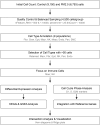PM2.5 exposure reprograms cell cycle dynamics in uterine immune cells at single-cell resolution
- PMID: 40236703
- PMCID: PMC11996630
- DOI: 10.3389/fimmu.2025.1561290
PM2.5 exposure reprograms cell cycle dynamics in uterine immune cells at single-cell resolution
Abstract
Background: Fine particulate matter (PM2.5) exposure has been associated with adverse effects on reproduction, yet the underlying cellular mechanisms remain poorly understood.
Methods: Using single-cell RNA sequencing, we systematically investigated cell cycle dynamics of immune cell populations in the mouse uterus following PM2.5 exposure. Analysis of 9,000 balanced cells was performed to identify distinct cell populations and characterize changes in cell cycle distribution and gene expression profiles.
Results: PM2.5 exposure induced distinct alterations in immune cell composition and cell cycle distributions. Notably, we observed significant changes in immune cell populations, including reductions in macrophages (510 to 58 cells), NK cells (445 to 91 cells), and granulocytes (1597 to 1 cells). Cell cycle analysis demonstrated cell type-specific responses to PM2.5 exposure: macrophages showed increased G1 phase representation (53.45%, +7.37%) with decreased G2M phase cells (18.97%, -12.79%), while NK cells exhibited relatively modest cell cycle alterations (G1: 28.6%, +2.5%; G2M: 45.1%, +2.6%; S: 26.4%, -5.1%). Differential gene expression analysis further identified crucial regulatory genes involved in cell cycle control, including Cd81 and Nrp1 in macrophages, Vps37b in NK cells. Integration of cell cycle markers with differentially expressed genes revealed distinctive phase-specific perturbations across immune cell types.
Conclusion: PM2.5 exposure induces cell type-specific alterations in cell cycle progression of uterine immune cells, which provides novel mechanistic insights into environmental pollution-induced reproductive dysfunction.
Keywords: cell cycle progression; fine particulate matter; immune cell heterogeneity; reproductive toxicity; single-cell RNA sequencing.
Copyright © 2025 Zhang, Tian, Zheng and Duan.
Conflict of interest statement
The authors declare that the research was conducted in the absence of any commercial or financial relationships that could be construed as a potential conflict of interest.
Figures






Similar articles
-
Single-cell RNA sequencing of estrual mice reveals PM2.5-induced uterine cell heterogeneity and reproductive toxicity.Ecotoxicol Environ Saf. 2024 Oct 1;284:116968. doi: 10.1016/j.ecoenv.2024.116968. Epub 2024 Sep 4. Ecotoxicol Environ Saf. 2024. PMID: 39236655
-
Exposure to particular matter increases susceptibility to respiratory Staphylococcus aureus infection in rats via reducing pulmonary natural killer cells.Toxicology. 2014 Nov 5;325:180-8. doi: 10.1016/j.tox.2014.09.006. Epub 2014 Sep 16. Toxicology. 2014. PMID: 25220797
-
Analysis by Metabolomics and Transcriptomics for the Energy Metabolism Disorder and the Aryl Hydrocarbon Receptor Activation in Male Reproduction of Mice and GC-2spd Cells Exposed to PM2.5.Front Endocrinol (Lausanne). 2022 Jan 3;12:807374. doi: 10.3389/fendo.2021.807374. eCollection 2021. Front Endocrinol (Lausanne). 2022. PMID: 35046903 Free PMC article.
-
Global gene expression profiling of human bronchial epithelial cells exposed to airborne fine particulate matter collected from Wuhan, China.Toxicol Lett. 2014 Jul 3;228(1):25-33. doi: 10.1016/j.toxlet.2014.04.010. Epub 2014 Apr 21. Toxicol Lett. 2014. PMID: 24769257
-
Maternal urban particulate matter (SRM 1648a) exposure disrupted the cellular immune homeostasis during early life: The potential attribution of altered placental transcriptome profile.Sci Total Environ. 2024 Feb 20;912:169432. doi: 10.1016/j.scitotenv.2023.169432. Epub 2023 Dec 20. Sci Total Environ. 2024. PMID: 38135080
References
-
- García-Peñarrubia P, Ruiz-Alcaraz AJ, Martínez-Esparza M, Marín P, MaChado-Linde F. Hypothetical roadmap towards endometriosis: Prenatal endocrine-disrupting chemical pollutant exposure, anogenital distance, gut-genital microbiota and subclinical infections. Hum Reprod Update. (2020) 26:214–46. doi: 10.1093/humupd/dmz044 - DOI - PubMed
MeSH terms
Substances
LinkOut - more resources
Full Text Sources
Miscellaneous

